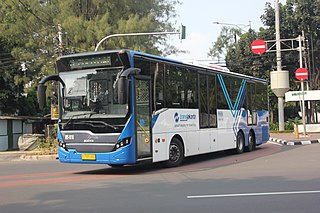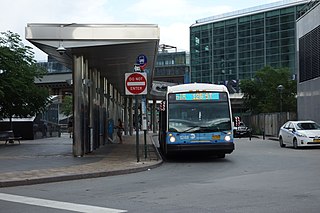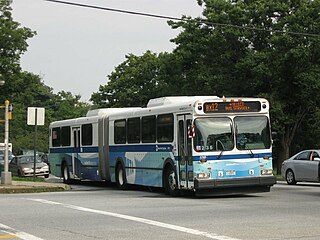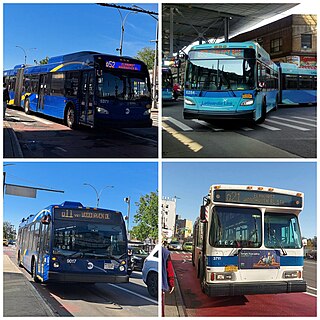
Bus rapid transit (BRT), also referred to as a busway or transitway, is a bus-based public transport system designed to have much more capacity, reliability and other quality features than a conventional bus system. Typically, a BRT system includes roadways that are dedicated to buses, and gives priority to buses at intersections where buses may interact with other traffic; alongside design features to reduce delays caused by passengers boarding or leaving buses, or paying fares. BRT aims to combine the capacity and speed of a light rail transit (LRT) or mass rapid transit (MRT) system with the flexibility, lower cost and simplicity of a bus system.

Miami-Dade Transit (MDT) is the primary public transit authority of Miami, Florida and the greater Miami-Dade County area. It is the largest transit system in Florida and the 15th-largest transit system in the United States. As of 2023, the system has 80,168,700 rides per year, or about 277,400 per weekday in the fourth quarter of 2023. MDT operates the Metrobus with their paratransit STS systems run by LSF. MDT also operates two rail transit systems: Metrorail and Metromover.
The Charlotte Area Transit System (CATS) is the agency responsible for public transportation in the Charlotte metropolitan area. CATS operates bus and rail transit services in Mecklenburg County and surrounding areas. Established in 1999, CATS' bus and rail operations carry about 320,000 riders on an average week. CATS is governed by the Metropolitan Transit Commission and is operated as a department of the City of Charlotte. In 2023, the system had a ridership of 13,476,600, or about 42,600 per weekday as of the fourth quarter of 2023.

Metro Rapid is a bus service in Los Angeles County, California, operated as part of the Los Angeles Metro Bus system. Metro Rapid service was introduced in the early 2000s to provide faster service on major corridors in Los Angeles, with stops spaced approximately 1⁄2 mile (800 m) apart.
Staten Island light rail proposals refer to two projects in the New York City borough of Staten Island. These proposals are among the several light rail projects that have been floated in New York City in recent years. Neither proposal was funded in the Metropolitan Transportation Authority's 2015–2019 Capital Plan, but $4 million was allocated to a study for it.

The First and Second Avenues Line, also known as the Second Avenue Line, is a bus line in Manhattan, New York City, running mostly along Second Avenue from Lower Manhattan to East Harlem. Originally a streetcar line along Second Avenue, it is now the M15 bus route, the busiest bus route in the city and United States, carrying 16.4 million riders annually. MTA Regional Bus Operations, under the New York City Bus and Select Bus Service brands, operates the local out of the Tuskegee Airmen Bus Depot and the SBS from the Mother Clara Hale Bus Depot. Service is operated exclusively with articulated buses.

Van Ness Bus Rapid Transit is a bus rapid transit (BRT) corridor on Van Ness Avenue in San Francisco, California, United States. The 1.96-mile (3.15 km) line, which runs between Mission Street and Lombard Street, has dedicated center bus lanes and nine stations. It was built as part of the $346 million Van Ness Improvement Project, which also included utility replacement and pedestrian safety features. Van Ness Bus Rapid Transit is used by several San Francisco Municipal Railway (Muni) lines including the 49 Van Ness–Mission, as well as three Golden Gate Transit routes.
The I-77 Bus Rapid Transit is a proposed bus rapid transit (BRT) service, connecting the towns in northern Mecklenburg and southern Iredell counties to Uptown Charlotte, North Carolina. The BRT replaces the previously planned commuter rail service, the Lynx Red Line, that was routed along the existing Norfolk Southern O-Line right-of-way. However, several issues had arisen that included ineligibility for federal funding and Norfolk Southern refusal to allow access to its right-of-way. In 2019, after a reevaluation of the entire corridor, the Charlotte Area Transit System (CATS) decided to move forward with BRT and shelve the commuter rail; which had been met with frustration by various city leaders and residents impacted by it.
The Lagos Bus Rapid Transit System, also known as Lagos BRT, is a bus rapid transit system in Lagos State. It is regulated by LAMATA and currently operated by Primero Transport Services Limited.

The Bx12 is a public transit line in New York City running along the 207th Street Crosstown Line, within the boroughs of Manhattan and the Bronx. The line runs along 207th Street in Upper Manhattan and along the continuous Fordham Road and Pelham Parkway in the Bronx.

Select Bus Service is a brand used by the Metropolitan Transportation Authority (MTA)'s Regional Bus Operations for limited-stop bus routes with some bus rapid transit features in New York City. The first SBS route was implemented in 2008 to improve speed and reliability on long, busy corridors.

MTA Regional Bus Operations (RBO) is the surface transit division of the Metropolitan Transportation Authority (MTA). It was created in 2008 to consolidate all bus operations in New York City operated by the MTA. As of February 2018, MTA Regional Bus Operations runs 234 local routes, 71 express routes, and 20 Select Bus Service routes. Its fleet of 5,840 buses is the largest municipal bus fleet in the United States and operates 24/7. In 2023, the system had a ridership of 730,924,600, or about 2,309,600 per weekday as of the fourth quarter of 2023.

The HealthLine is a bus rapid transit (BRT) line run by the Greater Cleveland Regional Transit Authority in Cleveland and East Cleveland, Ohio, United States. The line runs along Euclid Avenue from Public Square in downtown Cleveland to the Louis Stokes Station at Windermere in East Cleveland. It began operation on October 24, 2008. Its current name was the result of a naming rights deal with the Cleveland Clinic and University Hospitals of Cleveland. The HealthLine is denoted with a silver color and abbreviated simply as HL on most RTA publications.

Bus rapid transit in New Jersey comprises limited-stop bus service, exclusive bus lanes (XBL) and bus bypass shoulders (BBS). Under the banner Next Generation Bus New Jersey Transit (NJT), the New Jersey Department of Transportation (NJDOT), and the metropolitan planning organizations of New Jersey (MPO) which recommend and authorize transportation projects are undertaking the creation of several additional bus rapid transit systems (BRT) in the state.

sbX is a bus rapid transit (BRT) service in San Bernardino and Loma Linda, California, United States. It is operated by Omnitrans, a public transportation agency in southwestern San Bernardino County. The route is internally named by Omnitrans as the Green Line.

Rainbow BRTS is a bus rapid transit system in the city of Pune. The system is operated by the Pune Mahanagar Parivahan Mahamandal Limited (PMPML). The infrastructure has been developed by the Pune Municipal Corporation & Pimpri Chinchwad Municipal Corporation, Pune. The project currently envisages 113 km of dedicated bus corridors along with buses, bus stations, terminals and intelligent transit management system.

The Q11, Q21, Q52, and Q53 bus routes constitute a public transit corridor running along Woodhaven and Cross Bay Boulevards in Queens, New York City. The corridor extends primarily along the length of the two boulevards through "mainland" Queens, a distance of 6 miles (9.7 km) between Elmhurst and the Jamaica Bay shore in Howard Beach. The Q52 and Q53 buses, which provide Select Bus Service along the corridor, continue south across Jamaica Bay to the Rockaway peninsula, one of the few public transit options between the peninsula and the rest of the city.

Let's Move Nashville was a local referendum in Nashville, Tennessee, on May 1, 2018, that would have funded the construction of a mass transit system under the Nashville Metropolitan Transit Authority in Davidson County. The $8.9 billion plan would have included several light rail and bus rapid transit lines along major corridors, to be built between 2018 and 2032. The plan was proposed in 2017 by Mayor Megan Barry under the Tennessee IMPROVE Act and supported by some Nashville politicians and businesses.

Division Bus Rapid Transit, also known as Division BRT, is the working name for a planned bus rapid transit line in Spokane, Washington that will extend 9 miles from Downtown Spokane to the Mead, Washington area, north of Spokane. The line will be operated by Spokane Transit Authority, with a planned launch in 2027, and will be the region's second bus rapid transit line, after the City Line.
















